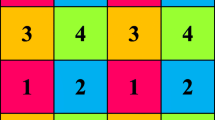Abstract
A prediction error histogram shifting (PEHS)-based reversible data hiding scheme is proposed in this paper. A novel representation for the secret stream, called signed-digit representation, is proposed to improve the image quality. The secret binary stream is first converted into a signed-digit stream, which results in a high occurrence of ‘0’. Meanwhile, a block-wise-based prediction is performed on the original image to generate prediction errors, which lead to a sharp prediction error histogram. Then, the converted signed-digit stream is embedded into the prediction errors according to the improved histogram shifting (HS)-based scheme with multiple selected peak points, resulting in an adaptive embedding capacity. The experimental results validate that the proposed scheme outperforms state-of-the-art schemes in terms of embedding capacity while maintaining a good image quality.










Similar content being viewed by others
References
Alattar AM (2004) Reversible watermark using the difference expansion of a generalized integer transform. IEEE Trans Image Process 13(8):1147–1156
Barton JM (2018) Method and apparatus for embedding authentication information within digital data. https://patents.google.com/patent/US6523114, accessed 22 February 2018
Celik MU, Sharma G, Tekalp AM, Saber E (2005) Lossless generalized-LSB data embedding. IEEE Trans Image Process 14(2):253–266
Celik MU, Sharma G, Tekalp AM (2006) Lossless watermarking for image authentication: a new framework and an implementation. IEEE Trans Image Process 15(4):1042–1049
Fallahpour M, Sedaaghi MH (2007) High capacity lossless data hiding based on histogram modification. IEICE Electron Express 4(7):205–210
He W, Xiong G, Zhou K, Cai J (2016) Reversible data hiding based on multilevel histogram modification and pixel value grouping. J Vis Commun Image Represent 40:459–469
He W, Cai J, Zhou K, Xiong G (2017) Efficient PVO-based reversible data hiding using multistage blocking and prediction accuracy matrix. J Vis Commun Image Represent 46:58–69
He W, Zhou K, Cai J, Wang L, Xiong G (2017) Reversible data hiding using multi-pass pixel value ordering and prediction-error expansion. J Vis Commun Image Represent 49:351–360
Hong W, Chen TS, Shiu CW (2009) Reversible data hiding for high quality images using modification of prediction errors. J Syst Softw 82(11):1833–1842
Horng SJ, Rosiyadi D, Fan P, Wang X, Khan MK (2014) An adaptive watermarking scheme for e-government document images. Multimed Tools Appl 72(3):3085–3103
Hsiao JY, Lin ZY, Chen PY (2017) Reversible data hiding based on pairwise prediction-error histogram. J Inf Sci Eng 33(2):289–304
Hu YC, Tsai PY, Yeh JS, Chen WL (2015) Residual histogram shifting technique based on cascading prediction for reversible data hiding. Advanced multimedia and ubiquitous engineering, Berlin, Heidelberg, 2015, pp. 105–110
Jung KH (2017) A high-capacity reversible data hiding scheme based on sorting and prediction in digital images. Multimed Tools Appl 76(11):13127–13137
Lee SK, Suh YH, Ho YS (2006) Reversible image authentication based on watermarking. Proceedings of IEEE international conference on multimedia expo,(Toronto, Canada, July 2006, pp. 1321–1324
Liu L, Chang CC, Wang A (2016) Reversible data hiding scheme based on histogram shifting of n-bit planes. Multimed Tools Appl 75(18):11311–11326
Muzzarelli M, Carli M, Boato G, Egiazarian K (2010) Reversible watermarking via histogram shifting and least square optimization. Proceedings of ACM workshop on multimedia and security, New York, USA, Sep. 2010, pp. 147–152
Ni Z, Shi YQ, Ansari N, Su W (2006) Reversible data hiding. IEEE Trans Circuits Syst Video Technol 16(3):354–361
Tang Z, Xu S, Yao H, Qin C, Zhang X (2019) Reversible data hiding with differential compression in encrypted image. Multimed Tools Appl 78(8):9691–9715
Tang Z, Xu S, Ye D, Wang J, Zhang X, Yu C (2019) Real-time reversible data hiding with shifting block histogram of pixel differences in encrypted image. J Real-Time Image Proc 16(3):709–724
Tian J (2003) Reversible data embedding using a difference expansion. IEEE Trans Circuits Syst Video Technol 13(8):890–896
Tsai PY, Hu YC, Yeh HL (2009) Reversible image hiding scheme using predictive coding and histogram shifting. Signal Process 89(6):1129–1143
Wang J, Ni J, Zhang X, Shi YQ (2017) Rate and distortion optimization for reversible data hiding using multiple histogram shifting. IEEE Trans Cybern 47(2):315–326
Weng S, Chen Y, Ou B (2019) Improved K-pass pixel value ordering based data hiding. IEEE Access 7:34570–34582
Xuan G, Chen J, Zhu J, Shi YQ, Ni Z, Su W (2004) High capacity lossless data hiding based on integer wavelet transform. Proceedings of IEEE international symposium on circuits system, Vancouver, Canada, May 2004, pp. 29–32
Yan Y, Cao W, Li S (2009) High capacity reversible image authentication based on difference image watermarking. Proceedings of IEEE international workshop on image system technology, Shenzhen, China, May 2009, pp. 179–182
Yang Y, Zhang W, Liang D, Yu N (2016) Reversible data hiding in medical images with enhanced contrast in texture area. Digital Signal Process 52:13–24
Yu C, Zhang X, Tang Z, Xie X (2018) Separable and error-free reversible data hiding in encrypted image based on two-layer pixel errors. IEEE Access 6:76956–76969
Zhou NR, Hou WMX, Wen RH, Zou WP (2018) Imperceptible digital watermarking scheme in multiple transform domains. Multimed Tools Appl 77(23):30251–30267
Zhou NR, Lou AW, Zou WP (2019) Secure and robust watermark scheme based on multiple transforms and particle swarm optimization algorithm. Multimed Tools Appl 78(2):2507–2523
Acknowledgments
This work is supported by Education and Scientific Research Project of Fujian Province under Grant JT180436, Natural Science Foundation of Fujian Province under Grant 2018 J01572 and Open Fund of Engineering Research Center for Software Testing and Evaluation of Fujian Province.
Author information
Authors and Affiliations
Corresponding author
Additional information
Publisher’s note
Springer Nature remains neutral with regard to jurisdictional claims in published maps and institutional affiliations.
Rights and permissions
About this article
Cite this article
Xie, XZ., Chang, CC. & Hu, YC. An adaptive reversible data hiding scheme based on prediction error histogram shifting by exploiting signed-digit representation. Multimed Tools Appl 79, 24329–24346 (2020). https://doi.org/10.1007/s11042-019-08402-6
Received:
Revised:
Accepted:
Published:
Issue Date:
DOI: https://doi.org/10.1007/s11042-019-08402-6




